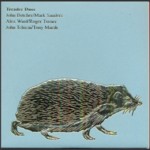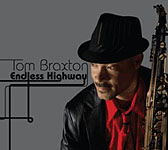Home » Jazz Articles » Live Review » The Profound Sound Trio at The Vortex Jazz Club, London
The Profound Sound Trio at The Vortex Jazz Club, London
The Vortex Jazz Club
North London, UK
November 23, 2009
The Vortex Jazz Club in North London is the city's best venue for improvised music in free jazz and other avant-garde sub-genres. On this Monday evening the aptly named Profound Sound Trio, consisting of drummer Andrew Cyrille, saxophonist Paul Dunmall and bassist Henry Grimes, took the stage for a stunning single-set performance that lasted the better side of one hour. Consisting of roughly four interlaced segments that saw Grimes switch from bass to violin and back again and Dunmall rotate from tenor to soprano to clarinet and back to tenor again, the group proved itself as occupying the cutting edge of modern-day jazz—or improvised instrumental music, if you will. In fact, the use of descriptive labels such as the aforementioned simply wash away once music of this level of integrity and courage fills a room.
The complete mastery of all forms of jazz as exhibited by these musicians is obvious to anyone with even a childlike level of curiosity. One need only glance at their joint discography to sense their level of musicianship—a roll-call of seminal names that range from Benny Goodman and Illinois Jacquet to Thelonious Monk and Cecil Taylor. So if there still persists the ill-informed view that this style of music is nothing more than ill-informed noise that doesn't swing, then it's probably a good idea beforehand to review the collective years of experience, skill and wisdom the Profound Sound Trio possess.
A trio is by definition a group made of three who play together as one. However, it's the individual, component parts that enable better understanding of the whole. The powerhouse British saxophonist Paul Dunmall, has accurately been dubbed a "post-Coltrane saxophonist," yet his playing on this occasion was both a confirmation and a revelation. His 1920s Conn tenor saxophone produced a granite-like tone, full of gusto and fire—apparently a difficult model to manipulate, unlike the "smooth-as-silk" Yamaha Custom. Dunmall nonetheless had the unwieldy beast at his mercy as he ripped through the entire instrument's register with a mastery of tonal colour, finger technique, breath control and rhythmic finesse, his sound simply filling the room.
Bassist Henry Grimes' lines, performed in single, double and triple stops, were relentless in their intensity, dazzling in their dexterity and magnetic in their ability to galvanize the group's tonal concept. His face was one of unblinking concentration, expressing little obvious emotion but trance-like in its elevated musical awareness. His famous beat and strong sense of forward momentum rang clearly throughout. Finally, Andrew Cyrille (nicknamed "Sir Real" or "Surreal" by musicians) proved that everything can be a drum as he took to beating out a rhythm first on his drummer's stool mid-set and then, with complete spontaneity, the thick black, hollow pole that stands like a monolith on the Vortex bandstand. With astonishing consistency and variety his drumming was a symphonic display of percussive mastery, rolling out a continuous succession of rhythms and counter rhythms, revealing a man whose ears are open to all the sounds around him and who is able to instantly respond in counterpoint to the sounds around him or to complement them. The sheer force and spread of his playing lifted the bandstand and indeed the entire club.
After the gig, Dunmall, responding to my question about the experience of performing with this trio, compared it to the feeling of taking off an overcoat in the heat of summer. He also talked of the great jazz musicians of the 1960s playing "on the edge" at the time but now—in 2009—the edge is somewhere else. Of course it is. Who still thinks that the related art of cinema is limited to the technological advances from fifty years ago? The edge is now. To quote Bird, "Now's the time."
Together then, this group performed an outpouring of creative music that was both aware of and rooted in the music's long and dense history yet fearlessly searching for the undiscovered, wherever and however it might appear. This was a listening band above all as evidenced by the varying tempi, identifiable but constantly shifting tonal centres, sense of dynamics, complete instrumental virtuosity and the need to communicate. This is the way forward for the music. It's OK to not swing, to not play 4/4, to not play the Spanish Tinge and even to not play the blues. You can of course do these things if you want to, as the Trio did when it felt a need to reflect the past of the jazz tradition, but it did not revert to established conventions as a prerequisite for playing jazz.
The other crucial thing to understand about this music is that, like the great jazz of the 1950s and 1960s, it captures the feeling of the time in which it is created. A convincing argument simply can't be made that someone playing, for example, Victor Young's "Stella By Starlight" in the 1958 fashion of Miles Davis' "First Great Quintet" is capturing the essence of our existence now in 2009, any more than Davis' performance of the same tune ten years later with the "Second Great Quintet" bore more than a token resemblance to the recording preceding it. Each recording was of its time, just as Albert Ayler's work, or the late, post-A Love Supreme recordings of John Coltrane, reflected the social unrest of their day. And so, The Profound Sound Trio captures many of the dominant feelings of our time—velocity, controlled chaos, all-inclusiveness, an awareness of the past rather than a nostalgia for it, unrestrained joy, the need for understanding, flexibility, uncertainty, complexity, simplicity—in a word—life.
Seconds before they began to play an encore, a chair made a squeaking noise, much like a ship's mast or a door that needs oiling. Dunmall heard it, imitated it vocally with a delighted smile on his face, and then used the sound as his melodic and rhythmic impetus. His band mates were right with him. Bassist Richard Davis did a similar thing on the the Eric Dolphy Five Spot (1961, New Jazz) recordings as did Thelonious Monk on the At The Blackhawk album (1960, Riverside). The jazz continuum lives on. The music lives on—a deeply-rooted tradition continually evolving with the unexpected, surprising developments of the moment of present experience. Pure magic.
Tags
PREVIOUS / NEXT
Support All About Jazz
 All About Jazz has been a pillar of jazz since 1995, championing it as an art form and, more importantly, supporting the musicians who make it. Our enduring commitment has made "AAJ" one of the most culturally important websites of its kind, read by hundreds of thousands of fans, musicians and industry figures every month.
All About Jazz has been a pillar of jazz since 1995, championing it as an art form and, more importantly, supporting the musicians who make it. Our enduring commitment has made "AAJ" one of the most culturally important websites of its kind, read by hundreds of thousands of fans, musicians and industry figures every month.





















